General Headquarters, South West Pacific Area, Section 22 was a secret radar intelligence organization established under General Douglas MacArthur in World War II. This posts is the first in a series of six that will include the entire 82 slide information packet that I sent to the CIMSEC Bilge Pumps pod cast which was recorded this morning (Feb 19, 20201) and will “air” Feb 24, 2021
The beginnings of the secret Australian radar countermeasures unit during the Pacific War Feb 2020
Student thesis: Doctor of Philosophy (PhD) – CDU
This is my “2-minute elevator speech” thumb nail of Section 22’s historical role in WW2 in the Pacific theater versus Japan that I sent to the Bilge Pumps pod cast crew.
THE BIRTH, LIFE & DEATH OF MACARTHUR’S SECTION 22 RADAR HUNTERS
In the aftermath of the “Channel Dash” or Unternehmen Zerberus (Operation Cerberus) in February 1942, the Royal Australian Navy decided after a series of meetings that it needed a radio/radar countermeasures (the modern term of art is “electronic warfare”) section to prevent the Japanese from doing to them what the Germans did to the UK Royal Navy when it snuck the fast battleships Scharnhorst and Gneisenau and the heavy cruiser Prinz Eugen through the English Channel with the assistance of radio and radar jamming.
(See: https://en.wikipedia.org/wiki/Channel_Dash)
This RCM section was based in Sydney and administered from the RAN Office in Melbourne. It’s commander was Lt. Cdr. Joel Mace, RANVR(sp) (RANVR decodes as – “Royal Australian Navy Voluntary Reserve” special)
There was then a decision made — either supported or stage managed by Mace, according to one of the scholars on the E-mail list I administer — to move the organization to Brisbane under the control of the USN’s 7th Fleet in or before May 1943.
Then in June 1943 this “Radio and Radar Countermeasures Division” was taken over by MacArthur’s South West Pacific Area General Headquarters (SWPA GHQ) under the direct command of General Spencer Akins, MacArthur’s Chief Signals officer and one of the “Bataan Gang.” A group of trusted American officers who were at Bataan with MacArthur.
This informal decision was ratified in GHQ Operations Instructions No. 36 issued by MacArthur on 5 July 1943 and in November the group was christened “Section 22” based on it’s officer number in a Brisbane office building.
Section 22 encompassed and organized disparate RCM elements in the US Army, US Fifth Air Force, US 7th Fleet, Royal Australian Air Force, Royal Australian Navy, Australian Army into a coherent whole to deal with the Japanese deployment of radar in the Rabaul and South Pacific areas in 1942-1943.
The organization reached its full maturity in the Summer of 1944 (see photo above) after it absorbed the South Pacific theater’s RCM organizations, primarily in the 13th Air Force, Royal New Zealand Air Force and Royal New Zealand Navy. South Pacific Theater having become a rear area by that time.
Section 22 supported General MacArthur’s drive to the Philippines and had a role in mapping Japanese radar networks throughout New Guinea, the Dutch East Indies, the Philippines, South China, Formosa and the Ryukyus (including Okinawa) and the Japanese home islands (See May 1943 Rabaul map below).
After the surrender of the Japanese in August/September 1945, Section 22 was disbanded. For a lot of political reasons, none of it’s best radar experts, who were Australian military or mobilized New Zealand physicist’s in military uniform, were involved in the postmortem evaluations of the Japanese military radar and associated electronics industries.
It is one of the great ironies of World War II that the best wartime Allied experts on Japanese military radar were not allowed to see the Japanese side of the radar was to deliver a coherent story of Japanese radar in WW2 as was done with the British military and German radar.
Below this paragraph are the first tranche of slides for the Section 22 information packet. These slides will be here on Chicagoboyz, on Twitter and on Facebook in a social media information campaign to get a larger, and more informed, audience for that pod cast.
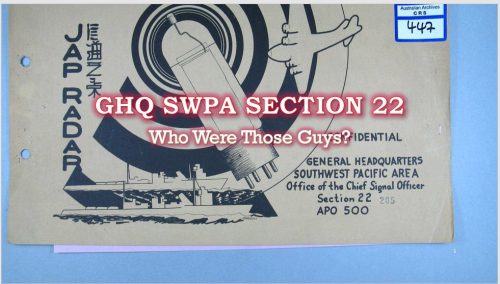
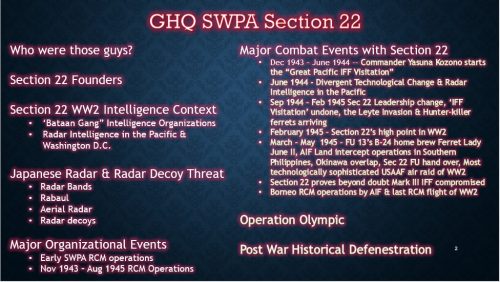
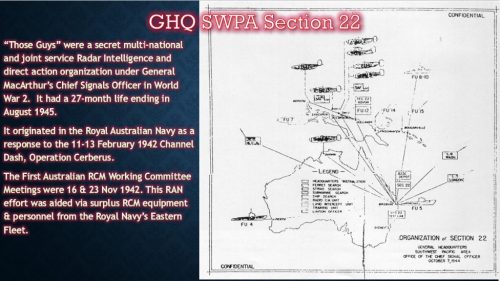

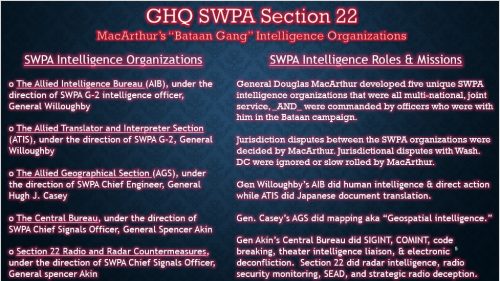
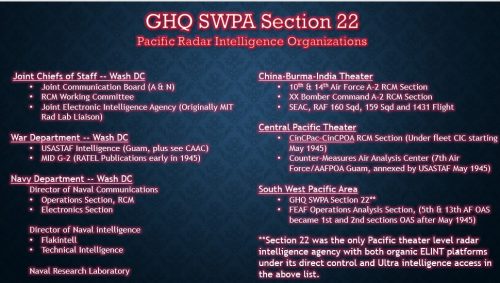
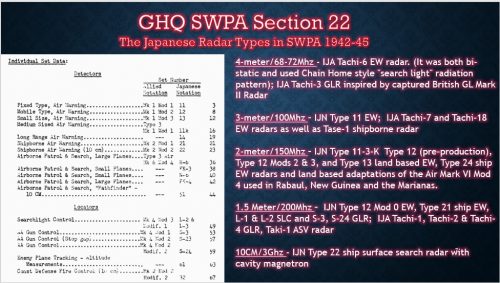
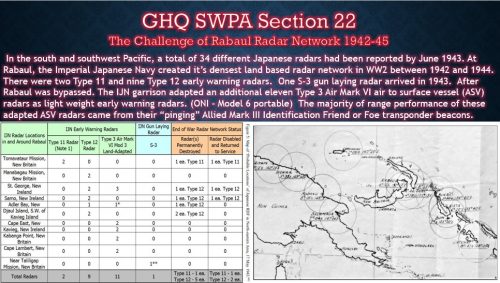
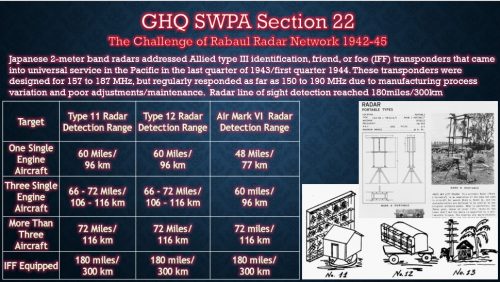

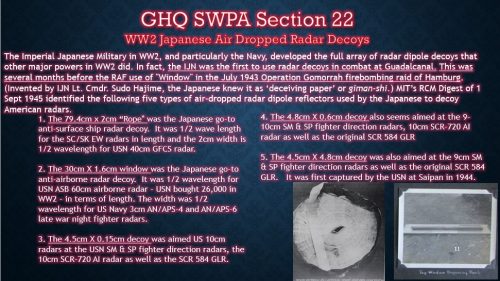
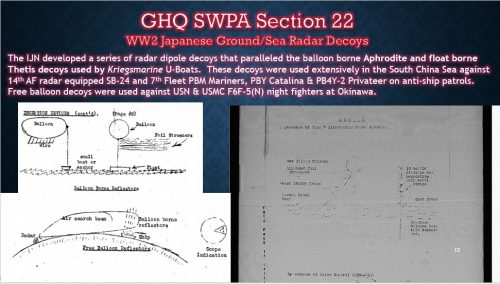
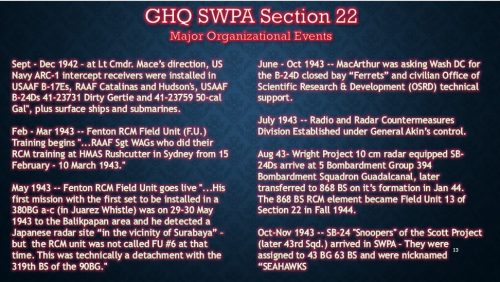
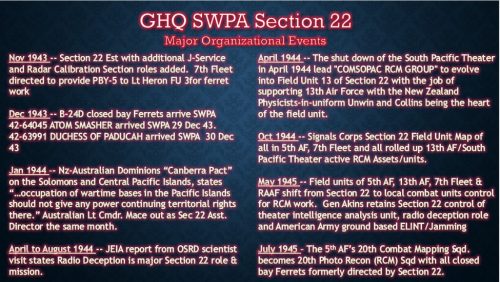
Slide fourteen above marks the end of the 1st day’s worth of slides. Every day through 24 Feb 2021 will have an additional post with slides and text building up to the debut of pod cast the Section 22 Special Interest Group e-mail list recorded Feb 19, 2021.
This is the website where the podcast will appear:
The Bilge Pumps
Interesting info about Japanese radar. Appreciated the pictures of the sites as well as some details about their abilities.
Over the decades I have come to believe allied WWII victory would eventually result despite many “what if” obstacles or “close calls” (Midway, U-Boats and the Battle of the Atlantic) and resultant different directions. He wins who can waste most. Russia could (and did) waste people; the U.S. had abundant resources with manufacturing isolated from attack.
Subservient to that generalized conclusion, I believe two factors proved decisive in both the Battle of the Atlantic (and N Africa) and the Battle of the Pacific: a) allied code breaking (allies read Rommel’s mail before he did, read Donitz’s and Yamamoto’s, too); b) radar.
Only in recent years have I seen details about the abilities and number of installations of either German or Japanese radar. Neither country matched the ability or quantity or even diversity (think AAA proximity fuses) of allied radar.
Roy,
The Japanese started behind and never caught up…but they got far closer than the Joint chiefs of staff wanted to admit for a lot of Pearl Harbor accountability and War/Navy Department merger “roles and missions” budget reasons.